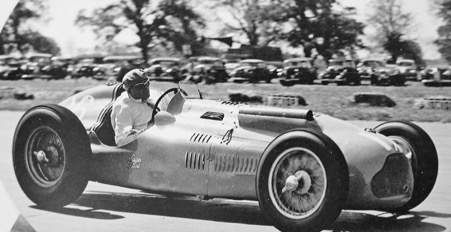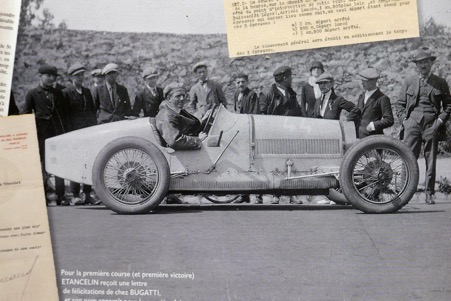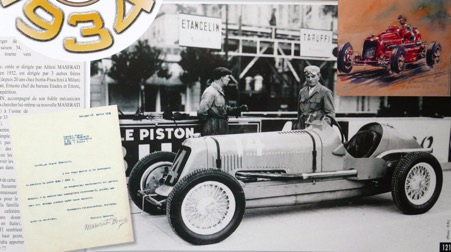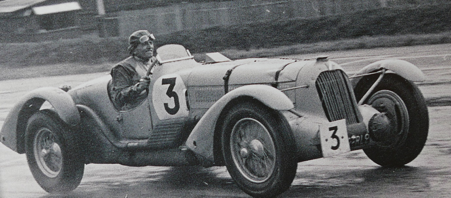I never met Philippe, “Phi Phi” Etancelin, the French grand prix driver who died in 1981 at the age of 84, but I think we could have had a fascinating conversation.

He did not have any plans to become a racing driver when, to celebrate the birth of Jeanne-Alice, his first child he bought his first grand prix Bugatti, an eight-cylinder type 35A Thecla,.
“Phi Phi” was 28 years old but he and his wife Suzanne were speed freaks boasting that they had hit just over 200 kph on the road and he had no intention of racing the Bugatti until two years later when he decided to enter for Staint-Leger-du-Bourg-Denis hill climb on the outskirts of Rouen and was hooked.

Etancelin was born in Rouen in 1896 and became what we would call a general dealer who bought and sold almost anything. As his grandson Andre Etancelin comments in the magnificently illustrated book of photographs and reproductions called Grand Prix Summum : Le Grande Livre de Bord d’un Pilote de Grand-Prix his grandfather travelled around farms in Normandy buying geese and duck feathers which he then sold on to manufacturers of pillows and mattresses at a good profit. When his first child was born he decided to buy his wife a diamond but rather than go to a jeweller he went to Paris, the Bugatti dealership, an paid 59,000 francs for a 35A Bugatti: the diamond would have to wait for another day!
At that early hill climb he realised this was what he wanted to do and had the means to do it. His wife was just as enthusiastic and became his pit manager.
His first serious circuit race, however, was in the 1927 Grand Prix de la Marne held on the new Reims circuit that attracted a large entry but Philippe just happened to be in Reims on business selling his feathers to a mattress maker, saw there was a race on and went to the organiser , the legendary Raymond Roche and asked for an entry. He was told the entry list was full and, anyway, there were a number of well known drivers in it. However, in practice a number of cars fell out and so Roche decided that to have an extra Bugatti on the entry list would look pretty good and so told Etancelin and his wife that he could race but would have to find somewhere to park his car in the packed paddock: also that he would have to start at the back of the grid and not pass anyone as he was there to make up the numbers. Not only did he start at the back of the grid but he overtook the entire field and won the race in 3 hours 26 minutes. The second place man, Michel Dore in a La Licorne finished a full 8 minutes and 16 seconds later ! Raymond Roche became one of Etancelin’s best friends.
As Andre Etancelin, Philippe’s grandson explained to me, he found that Philippe Etancelin and his wife kept every single item linked to his entire racing career and the following stories and illustrations come from the wonderful book he produced and paid for out of his own pocket as a celebration of his grandfather.
Only 500 copies of the book were printed and it reads like a social history of a bygone age and brings to life the atmosphere of the time. Take, for example, the first Monaco Grand Prix on April 14 1929.
By now Etancelin was driving a Type 35C Bugatti and thanks to the fact that the organisers decided to ignore practice times and draw the grid by ballot, Etancelin found himself on pole position. On the very first lap he was overhauled first by Marcel Lehoux and then by the eventual winner Grover Williams and was to finish sixth. Typical of Philippe’s souvenirs was the menu for the post-race Gala Dinner which he duly had autographed by Williams, Lehoux, ,and Rudolf Caracciola driving a Mercedes Benz SSK.

By the end of 1933 Phi Phi decided he wanted a change so he, his mechanic and his wife Suzanne went to Bologna to meet up with Alfieri Maserati and bought a new Maserati 8CM (Chassis 3010).
Suzanne took with her a brand new Cona coffee machine which you could not buy in Italy and gave it to Alfieri and his wife as a present. The letter to the bottom left of the page showing his new car was from Alfieri’s wife thanking them for the coffee machine. Etancelin kept the car for the season but at the end of 1934 he sold it. It was later entered by Harry Schell for the 1946 Indianapolis 500 but blew its engine and today is preserved in the Schlumpf museum in Mulhouse.
During 1934 he had another new experience when he was entered for the 24 hour race at Le Mans alongside Luigi Chinetti in and Alfa Romeo 8C. Philippe had rented the Alfa Romeo as he was contracted to Esso who put pressure on him to enter for the race.
They won the race by a country mile ahead of two Riley Nines despite losing 13 minutes when the lights kept going out at 2.30 in the morning. Etancelin also set the fastest lap in the race but was not impressed.
He complained he was only doing 125 mph on the Mulsanne Straight and swore he would never go back but was persuaded by Luigi Chinetti to do the 1938 race in a Talbot T26SS but the engine blew up on the 66th lap and that was it as far as Le Mans was concerned.
In 1935 there was correspondence with Enzo Ferrari who wanted Philippe to join Scuderia Ferrari but after reading the conditions he realised that if, for example, he was leading a race he could be ordered to give up the place if another Alfa Romeo was considered able to win. The correspondence published in the book makes interesting reading.
He continued racing Maserati’s for Scuderia Sub Alpina but it was clear that Philippe Etancelin was surely one of the better grand prix drivers of a period when Mercedes Benz and Auto Union dominated the headlines. He raced in the United States for the first time in the Vanderbilt Cup and finished 8th with a Maserati RV8 and though he was on the front of the grid he finished 8th.

Two years later he was at Donnington Park in England driving as usual with no crash helmet and his cap back to front on his head. He was to continue with this routine even when forced to wear a crash helmet after WWII and put his cap back to front over his helmet ! In that RAC TT at Donnington he finished third driving a Talbot and his last race before WW II was the French Grand Prix at Reims with a Talbot-Darracq greatly outpowered by the four Auto Unions and Four Mercedes Benz grand prix car but he had the satisfaction of out-qualifying his friend Luigi Chinetti in an Alfa Romeo 308.
In April 1945 at the age of 44 he raced again in the Grand Prix of Nice with a Maserati 6CM that had survived the conflict but retired early on.
He raced spasmodically and was one of the entrants for the very first Formula 1 Grand Prix Race at Silverstone in 1950 when he was 54 years of age. His regular car by now was a Talbot Lago T26|C and as usual, privately entered but again he finished 8th overall which was a remarkable performance for a man of his age in a world championship grand prix.
